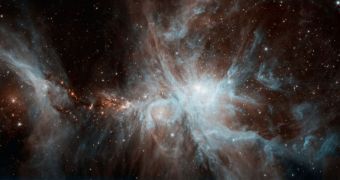Scientists at the American space agency have just revealed the latest image they produced of the famous Orion Nebula. The photograph, which was snapped using the NASA Spitzer Space Telescope, one of the four Great Observatories the agency built, shows in great detail the active stellar formation processes taking place in the renowned structure, the team behind the investigation says. In the particular range of infrared wavelengths that Spitzer uses, a large number of hot, young stars have become visible in the new observations, Space reports.
The nebula is located in the “sword” of the Orion constellation (the Hunter). This stellar pattern has been observed since ancient times, researchers say, and many civilizations paid tribute to it. The new NASA image shows the massive amount of stellar gas and dust that permeate the large nebula. Hydrogen gas clouds glow from the massive amount of radiation that blue stars inside it spew out. This is very beneficial for the stellar formation process, as these stellar winds stir and mix the gas and dust, allowing it to accumulate to the concentrations needed to fall in on themselves, and then ignite.
Astronomers plan to use the new datasets to gain more knowledge into why the stars inside the Orion Nebula change and to what extent this process is affected by planetary formation around these celestial bodies. “This is an exploratory project. Nobody has done this before at a wavelength sensitive to the heat from dust circling around so many stars. We are seeing a lot of variation, which may be a result of clumps of warped structures in the planet-forming disks,” says NASA Spitzer Science Center (SSC) principal research investigator, John Stauffer.
The SSC is based in Pasadena, at the California Institute of Technology (Caltech). The image was snapped by Spitzer in May 2009, shortly after it ran out of helium coolant. This forced the team managing the machine to begin a new, “warm” science phase. In this case, the temperature of the telescope is currently at minus 406 degrees Fahrenheit (minus 243 degrees Celsius). The observations session that yielded this new image, just one in 80 others, took 40 days to complete. About 1,500 variable stars have been identified in Orion this far, thanks to Spitzer studies.

 14 DAY TRIAL //
14 DAY TRIAL //